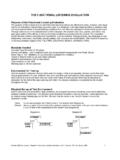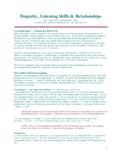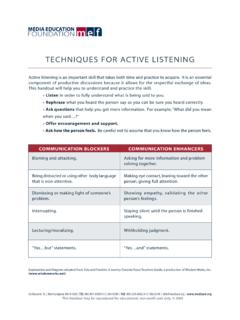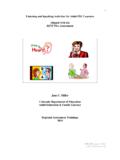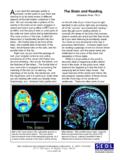Transcription of Listening Comprehension Research: A Brief Review …
1 Dialogue, 2004, Vol. 3, pp. 53-66 Copyright 2004 TALK ISSN 1349-5135 53 Listening Comprehension research : A Brief Review of the Past Thirty Years NOBUKO OSADA Waseda University (Part-time lecturer) Abstract This paper attempts to clarify what has and what has not been revealed in the literature so far in order to gain a better understanding of the nature of Listening Comprehension . First, in the section A Historical Overview of Listening Comprehension Studies, the changes that Listening Comprehension has undergone in the past few decades will be observed.
2 Listening Comprehension has long been regarded as a passive skill, and researchers considered it an ability that would develop without assistance. Around 1970, Listening Comprehension began to attract much attention and started to be explored. Some points have been revealed while others have remained unrevealed during the past thirty years. Then in the section Components of Listening Comprehension , the basic difference between written language and spoken language will be observed. It is important to note that the type of medium sound versus print will generate a wide range of input styles in spoken and written language (see the section Features of spoken language ).
3 In addition, the difference between written and spoken language Comprehension will be discussed so that we can understand that Listening Comprehension imposes upon learners a different cognitive load from that of reading Comprehension (see the section Differences between Listening and reading Comprehension ). Furthermore, seven conceivable causes of obstacles to efficient Listening Comprehension will be identified (see the section Potential problems in learning to listen to English ). Keywords: Listening Comprehension , Cinderella skill, literature Review 1.
4 Introduction Although Listening is now well recognized as a critical dimension in language learning, it still remains one of the least understood processes. According to Morley (2001), during the 1980s special attention to Listening was incorporated into new instructional frameworks, that is, functional language and communicative approaches. Throughout the 1990s, attention to Listening in language instruction increased dramatically. Listening Comprehension is now NOBUKO OSADA 54 Dialogue, 2004, Vol. 3 generally acknowledged as an important facet of language learning; nevertheless, much work remains to be done in both theory and practice (Morley, 2001, p.)
5 69). In this paper, an attempt will be made to clarify what has been discussed in the literature for the past thirty years. 2. A Historical Overview of Listening Comprehension Studies Until recently, Listening Comprehension attracted little attention in terms of both theory and practice. While the other three language skills ( , reading, writing, and speaking) receive direct instructional attention, teachers often expect students to develop their Listening skill by osmosis and without help (Mendelsohn, 1984; Oxford, 1993). In the osmosis approach (as it is cynically labelled by Mendelsohn (1984)), also known as the Audiolingual method, it is believed that if students listen to the target language all day, they will improve their Listening Comprehension skill through the experience.
6 The fact that Listening has been neglected or poorly taught may have stemmed from the belief that it is a passive skill and that merely exposing students to the spoken language provides adequate instruction in Listening Comprehension (Call, 1985). The roots of audiolingualism lie in the early years of the 20th century, and had a significant influence on theories of language teaching. Among these were: (a) the entrenchment of positivistic pragmatism, (b) the blossoming of American structural linguistics and behaviorist psychology, and (c) the expression of scientific thought through formalisms (Johnson & Johnson, 1998).
7 Behaviorists drew inspiration from Pavlov s conditioning experiments, which promoted an account of behavior in terms of stimulus and response and suggested that these could be expanded into an ever-widening network through association and newly learned responses strengthened through reinforcement. Language development was thought to be explained in a similar way; languages are ultimately finite entities and might be learned through imitation and practice. This traditional approach to Listening , which treated it as an enabling skill for production-oriented activities, has trapped students in a frenzied Hear it, repeat it!
8 , Hear it, answer it! , or Hear it, translate it! nightmare (Meyer, 1984, p. 343). In addition to the American Audiolingual Approach, the English language teaching programs of the British Situational Approach did not pay much attention to Listening beyond its role in grammar and pronunciation drills and learners imitation of dialogues during the Listening Comprehension research : A Brief Review of the Past Thirty Years 55 1940s, 1950s, and 1960s (Morley, 2001). Arguments for Listening Comprehension began to be voiced in the mid-1960s by Rivers, who has been long an advocate for Listening Comprehension (Morley, 2001, p.)
9 70). Rivers (1966) had enough foresight to say that, Speaking does not of itself constitute communication unless what is being said is comprehended by another person (p. 196), and that Teaching the Comprehension of spoken speeches is therefore of primary importance if the communication aim is to be reached (p. 204). One of the events that brought about this paradigm shift was the Second AILA (International Association of Applied linguistics) Conference in 1969 which was held in Cambridge, England. As Morley (2001) states, in retrospect, the four themes that dominated the conference seem to have been prophetic in pointing the way toward the trends in second or foreign language education during the last quarter of the twentieth century.
10 New views on the importance of the following issues were proclaimed at the conference: (a) individual learners and the individuality of learning, (b) Listening and reading as nonpassive and very complex receptive processes, (c) Listening Comprehension s being recognized as a fundamental skill, and (d) real language used for real communication as a viable classroom model (Morley, 2001). Then, slowly and steadily, more attention has been given to Listening Comprehension . In the 1970s, the status of Listening began to change from being incidental and peripheral to a status of central importance.
